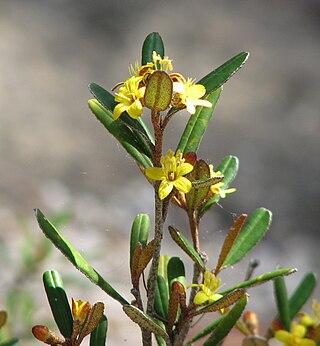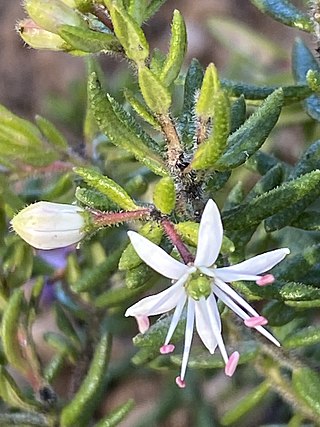
Phebalium whitei is a small shrub that is endemic to south-east Queensland. It has branchlets covered with silvery and rust-coloured scales, leathery, oblong to elliptic leaves and bright yellow flowers arranged in sessile umbels on the ends of branchlets.

Leionema phylicifolium, commonly known as alpine phebalium, is a shrub that is endemic to south-eastern Australia. It is a small shrub with green, smooth, leathery leaves and pale yellow flowers in spring.

Leionema gracile, commonly known as Mt Greville phebalium, is a shrub species that is endemic to Queensland, Australia. It is a small shrub with spreading leaves, white petals and flowers from autumn to spring.
Leionema lachnaeoides, is a tall shrub with aromatic leaves and yellow flowers from winter to late spring. It is restricted to the Blue Mountains in New South Wales.

Leionema microphyllum, commonly known as limestone phebalium, is a small shrub with terminal clusters of white-pink flowers in spring. It is a rare plant in Victoria and South Australia.
Phebalium drummondii is a species of small shrub that is endemic to Western Australia. It has smooth branchlets covered with silvery scales, broadly elliptic to egg-shaped leaves with silvery scales on the lower side and bright yellow flowers arranged in umbers on the ends of branchlets.

Leionema oldfieldii is a small shrub that is endemic to mountainous locations in Tasmania, Australia. It has dark green leaves, compact pale pink to white flowers from November to January.

Asterolasia nivea, commonly known as Bindoon starbush, is a species of weak sub-shrub that is endemic to the southwest of Western Australia. It has leathery oblong to narrow elliptical leaves and white flowers arranged in groups of about three flowers with thick-centred, shield like, star-shaped hairs on the back of the petals.

Leionema rotundifolium, is a dense shrub with needle-shaped stems and pale lemon to white terminal flowers. It is found in New South Wales and Queensland.

Leionema viridiflorum commonly known as green phebalium, is a species of flowering plant in the family Rutaceae. It is a small shrub with pale yellow-greenish flowers in clusters at the end of branches from winter to early spring. It has a restricted distribution in northern New South Wales.

Rhadinothamnus euphemiae, is a slender, small, upright shrub with needle-shaped branchlets thickly covered with silvery scales and tubular greenish-purple tubular flowers throughout the year. It is endemic to the south coast of Western Australia.

Muiriantha is a genus of plant containing the single species Muiriantha hassellii and is endemic to the south coast of Western Australia. It is a small shrub with branchlets covered sparsely in hairs, leathery leaves and yellowish-green pendulous flowers.

Nematolepis elliptica, is a small, bushy shrub with white flowers in small clusters from September to November. It is endemic to the south coast of New South Wales.

Nematolepis ovatifolia, is a small shrub with rusty coloured scales on the stems, smooth, glossy leaves and white flowers in small clusters in summer. It is endemic to New South Wales.

Diplolaena andrewsii, is a species of flowering plant in the family Rutaceae and is endemic to the west coast of Western Australia.
Diplolaena cinerea, is a species of flowering plant in the family Rutaceae and is endemic to the west coast of Western Australia. It has pale orange flowers, papery, elliptic shaped leaves that are covered in star-shaped hairs on the upper surface.

Diplolaena dampieri, commonly known as Dampier's rose, is a species of flowering plant in the family Rutaceae. It is endemic to the west coast of Western Australia. It has slightly leathery, oblong-elliptic shaped leaves, hairy bracts and pale red to orange flowers from July to September.
Diplolaena drummondii is an endemic Australian flowering plant in the family Rutaceae. It is only found in Western Australia. It is a small, spreading shrub with oblong to elliptic papery, thin leaves, and yellow, orange or reddish flowers which bloom between July and November.

Diplolaena microcephala is a rounded shrub with elliptic leaves, distinctive stamens, variable flower colour and is endemic to Western Australia.

Diplolaena graniticola, is a species of flowering plant in the family Rutaceae. It is a small shrub with yellow or red pendulous flowers and papery leaves. It is endemic to Western Australia.
















